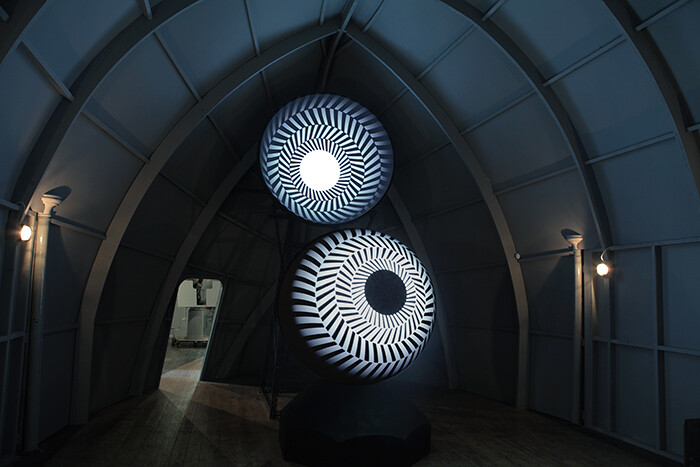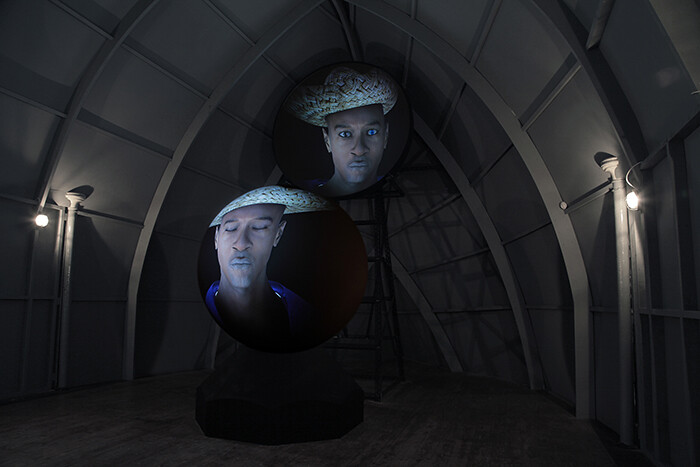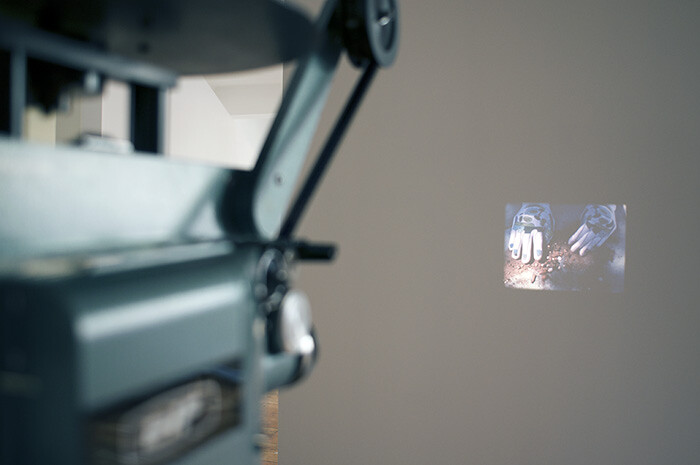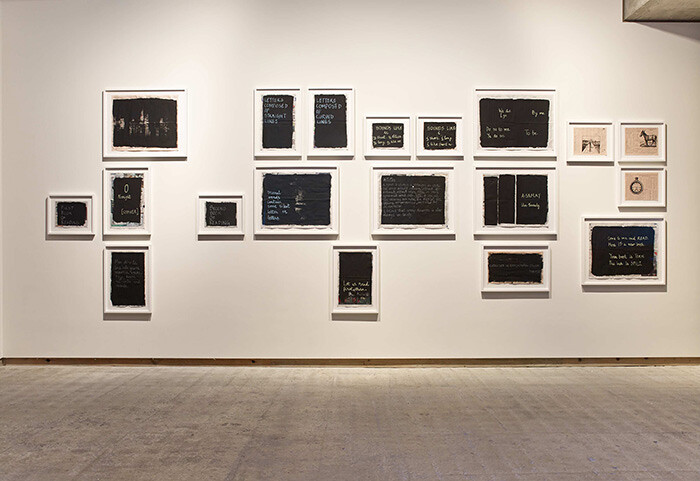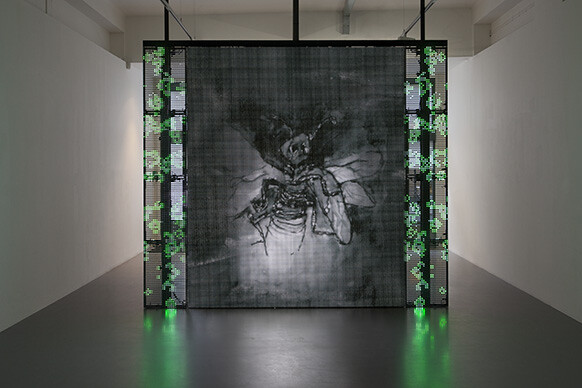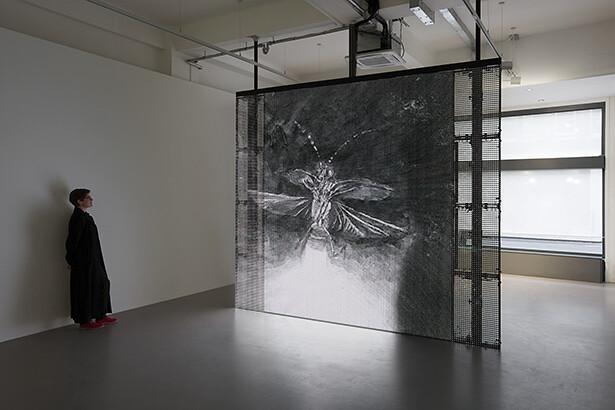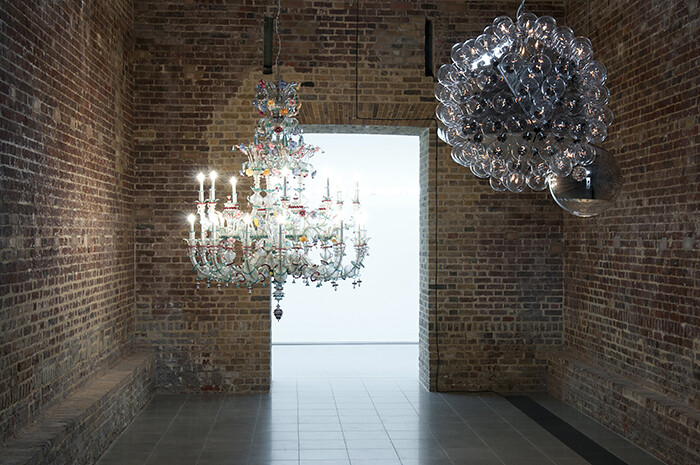Outside the Frieze Art Fair’s tented metropolis in Regent’s Park, London’s more permanent gallery spaces this week offered countless illuminated or screen-based spectacles. I was transported, more than once, into other worlds: dizzying screen-spaces in which gender, geography, and time blur and fracture. This was all the more pronounced because, inside the fair, such works were scarce: the Frieze Film section has been abandoned, replaced by a lackluster performance programme. Nevertheless, the city’s commercial and public galleries host a vast array of moving-image works, immersive installations, and soundscapes.
The biggest of these otherworldly media-friendly extravaganzas is “MIRRORCITY”—the zaniest and therefore the best show I’ve seen at Hayward Gallery in years. Dealing with the “digital revolution,” science fiction, and the city, the exhibition is wonderfully muddled. Phlegmatic hacks such as The Guardian’s Jonathan Jones hated it, and failed to engage with its challenges.1 “MIRRORCITY” is not a one-liner show: it stakes a claim to the muddy terrain of human experience in toto—sexuality, identity, fantasy, and geopolitics—and there are delights aplenty: a vast, upturned boat-shaped edifice, which houses a moving-image work by Lindsay Seers (Nowhere Less Now, 2014, a new version of a work first presented in 2012 as an Artangel commission); Ursula Mayer’s Medea (2013) and Gonda (2012), two sumptuous film works that dazzle the viewer with baroquely costumed transgender performers and slabs of colour; Tai Shani’s brilliantly kitsch diorama with video narration, Dark Continent (2014); and Anne Hardy’s immersive and oddly calming installation environment Two Joined Fields – Field (/\) and Field (decagon) (2013).
What are the common threads? Seers, Mayer, Shani, as well as Laure Prouvost and Katrina Palmer all present works that delve into psychic terrains of fantasy and confession, constructed identities, sexuality, and escape. There are motifs of political dissent in works by Mayer, whose Medea samples footage from recent (but unspecified) Arab revolutions; and Brad Butler and Karen Mirza’s How to Protest Intelligently (2014)—a modified series of posters, which the artists found on the streets of Cairo while on a residency there in 2011, that give instructions to activists. Other works sent my thoughts spinning off in alternative directions: into the history of sculpture (Helen Marten), into sound technologies and echoes of the past (Aura Satz), and into digital archives and media mutations (Hannah Sawtell).
Elsewhere in town, Istanbul-based Rodeo gallery has just opened a new location on the fringes of Soho. On view in the first of the gallery’s two-floor spaces is Tamara Henderson’s What’s Up Doc? (2014), a 16mm film very loosely about tourism—or at least the old-school aesthetics of high street travel agents, with their promises of exotic adventure in Brazil or Jamaica. The film is made of a series of non-sequiturs heavily redolent of classic Surrealist film: strands of seaweed defy the forces of nature and drag themselves out of a briny shoreline (pulled by invisible string); colorful atlases are shredded into a brown pulp in a food blender; a white-gloved hand on which are marked various body parts gestures pointlessly. In the gallery’s top-floor space, Banu Cennetoğlu exhibits 04.09.2014 (2014), a vast collection of local British newspapers collected on the eponymous date—a deliberately futile attempt to archive and detail the obsessions of a nation.
At Frith Street Gallery, Raqs Media Collective present a body of new works also related to the history of printed news. Unfortunately, the title of their exhibition, “Corrections to the First Draft of History” is presumptuous and portentous, and the exhibition itself follows suit. The eponymous work (2014) is made up of an array of newspapers over which the artists have painted cryptic words or sentences such as “0 Nought [Cypher]” and “LETTERS COMPOSED OF STRAIGHT LINES.” The most visually arresting work exhibited, Rerun (2013) is a large video projection of actors recreating a photograph by Henri Cartier-Bresson depicting a bank run in Shanghai in late 1948, on the eve of the revolution. The subject may be politically loaded, but because the artists merely quote the image and stake nothing as to its contemporary relevance, Rerun is lost in history. In Raqs’s hands, time is nebulous and abstract, its politics unmoored and floundering.
Philippe Parreno, by contrast, delivers a visual punch that captures the briefest flash of time. The main work shown in his solo exhibition at Pilar Corrias—With a Rhythmic Instinction to be Able to Travel Beyond Existing Forces of Life (2014)—is a large panel of hundreds of LED lights that flash on and off, creating a retina-burning series of images of fireflies; these images are based on drawings Parreno has made of the lucciola bug over the past four years. There’s a circular logic at work here: computerized patterns of electric bulbs depicting insects that emit light. More than that, however, each flickering image (lasting only a brief moment) suggests a life that has come and gone in an instant, a potent allegory of life and death. Between the gallery space and the street, Parreno has installed One Blind Sister (2014), a mechanized roller blind that ascends and descends in reaction to noises on the street outside. It’s evidently an attempt to root the gallery experience within the fabric of the city—a noble idea, but one that felt far too gimmicky.
Also working with light is Cerith Wyn Evans, who is showing a group of works using neon lettering, baroque chandeliers, halogen bulbs, and heating elements at the Serpentine’s Sackler Gallery. The exhibition was not in any way surprising: at his much larger solo show in 2012 at the De La Warr Pavilion—a grand modernist building on the seafront of Bexhill-on-Sea, on the south coast of England—the seaside sun and illuminated artwork combined into a powerful, emotive encounter. The effect was less striking at the Serpentine. It was, nevertheless, salutary to see Evans’ work in the context of the other exhibitions. Evans is one of the threads that knit together current moving-image practice with the queer Conceptualism of the 1990s (Félix González-Torres, Robert Gober), and further back to the baroque New Romantic work of his early career in the 1980s. In the dazzle of these flashing lights and screen spectacles, there are identities being crystalized, smashed, and remoulded: protean, quick, and complex.
Jonathan Jones, “Mirrorcity review – reflections on a relentless rush of nonsense,” theguardian.com (last modified October 14, 2014), http://www.theguardian.com/artanddesign/2014/oct/14/mirrorcity-exhibition-review-hayward-gallery-digital-age.

